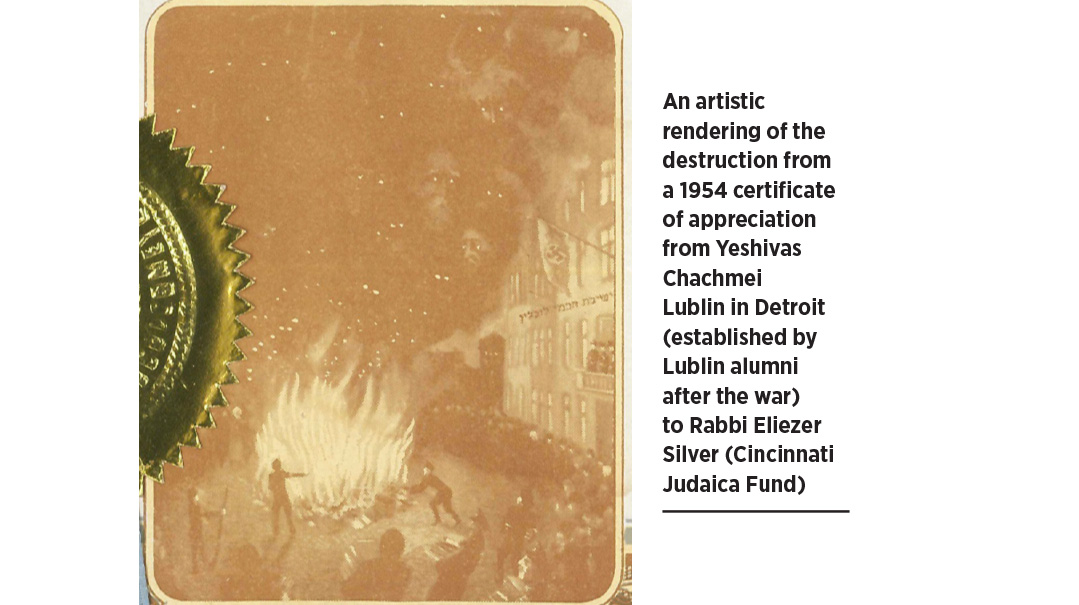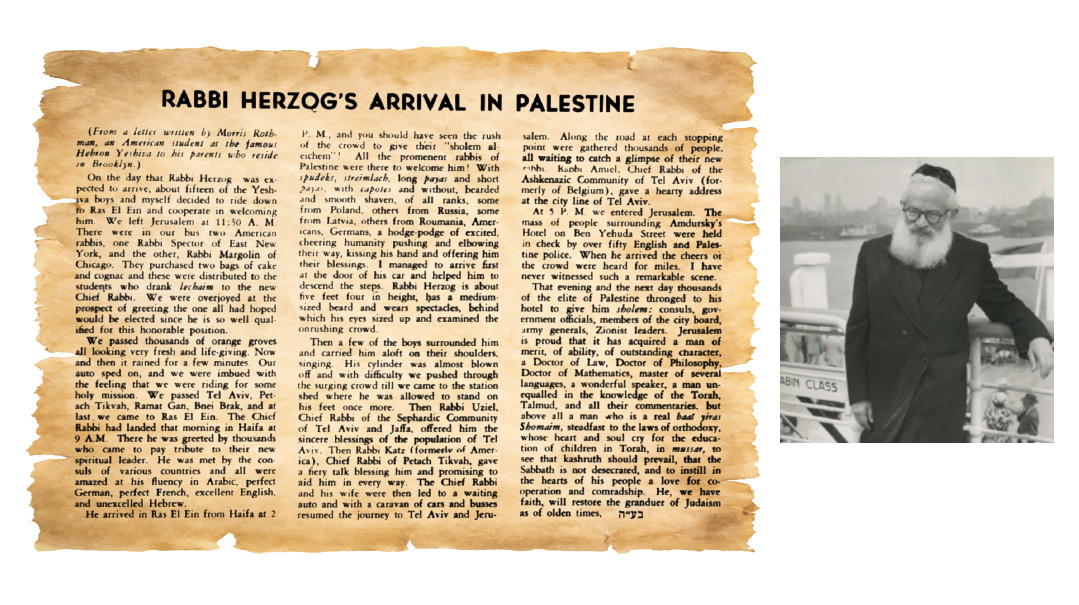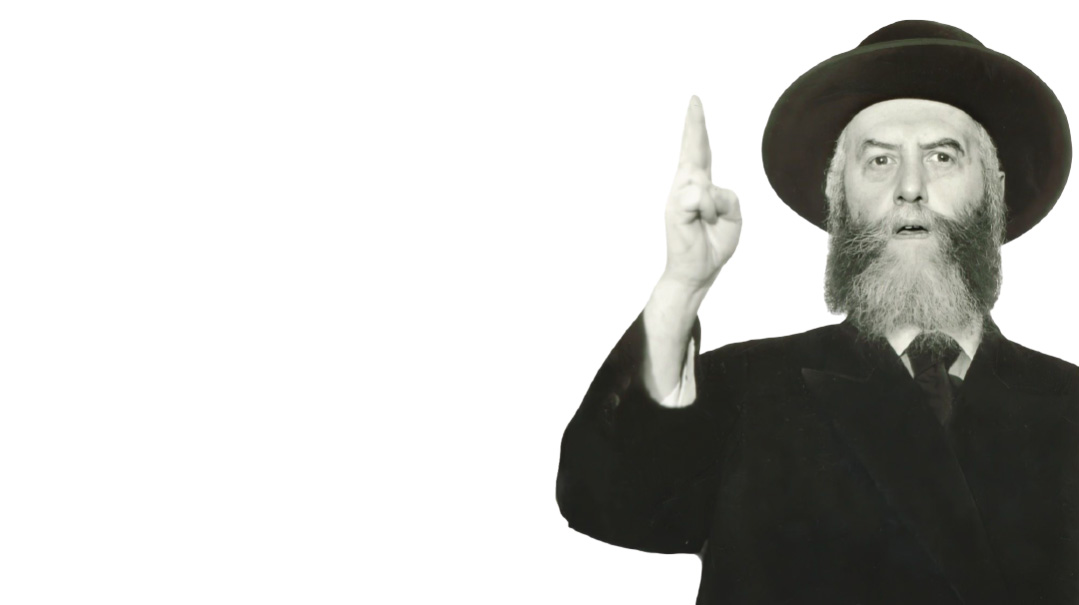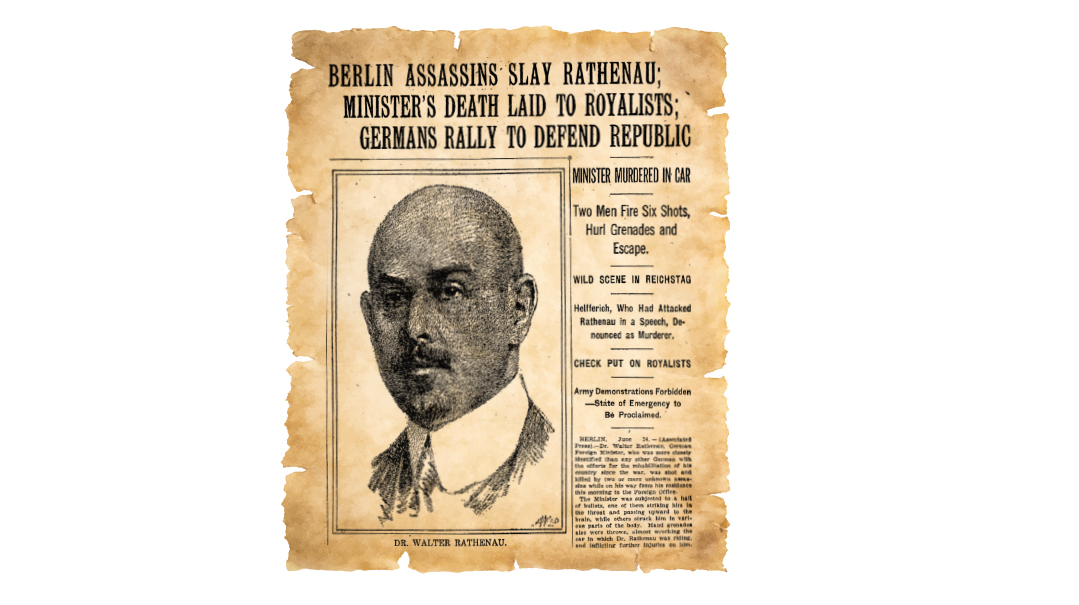The Legend of the Lost Library of Lublin
| December 6, 2022It’s quite certain that the yeshivah library was not destroyed by the Germans

Title: The Legend of the Lost Library of Lublin
Location: Lublin, Poland
Document: Artistic rendering of the destruction of the Yeshivas Chachmei Lublin library
Time: 1940s
It’s axiomatic for those discussing Yeshivas Chachmei Lublin on Jewish history tours of Poland that the famed yeshivah’s library was burned by the Nazis following their occupation of the city in September 1939. That’s what was reported by the Deutsche Jugend-Zeitung newspaper in February 1940. Or so alleged the Hatzofeh newspaper in Palestine in January 1941, citing the Nazi newspaper’s dispatch from a year earlier. The German article supposedly described the 30,000-volume collection being burned publicly in the yeshivah courtyard, saying that “the Jews stood and cried as the flames burned for 24 hours. Their cries almost deafened us. We brought an army band and the joyous tones of the military music covered the cries of the Jews.”
There’s only one problem with the story: It never happened.
Chachmei Lublin founder Rav Meir Shapiro’s grandiose vision for the yeshivah included amassing the largest seforim library in Poland. In a 1926 interview with journalists on a fundraising trip to the United States, Rav Meir Shapiro proudly shared his plans:
We have space for 1,000 students to learn and for 500 to sleep and eat. The library on the day of its opening will hold 20,000 volumes. The yeshivah was established to facilitate the best in the Jewish young man. The conditions in which he finds himself must be adequate to allow him to develop to the maximum.
This library wouldn’t have existed had it not been for generous donors from all over Poland and abroad. Rabbi Binyamin Gut of the Chasam Sopher synagogue in New York donated as many as 4,000 volumes and $1,000 to the library. Special committees established throughout Poland sent thousands of books to Lublin, including priceless old prints and manuscripts, which they collected from institutions and private donors. In 1930, when the yeshivah was opened with a grand ceremony, the library already included several thousand volumes and was constantly growing. Although by the end of the 1930s the yeshivah probably had not managed to collect the planned 100,000 volumes, it had become one of the largest and most valuable Jewish religious libraries in Poland at that time.
With the Nazi occupation of Poland in 1939, the yeshivah building and assets were seized. Valuable collections were more often looted by the Nazis rather than destroyed. And that was exactly the fate of the Lublin library. The Nazi authorities tasked a prominent Lublin talmid named Rav Aharon Lebwohl with cataloguing the crates of seforim from the yeshivah library for future reference. Though he labored on this task from April 1941 until he was murdered in the gas chambers in Majdanek in November 1942, it was far from complete. His catalog has never been found.
It’s possible that the Nazis transported at least some of the books to Berlin, Prague, or some other location ahead of the Soviet advance near the end of the war. It’s known, however, that the bulk of the collection remained intact in Lublin following liberation.
On November 23, 1944, the first postwar Jewish newspaper in Poland, Lublin’s Bulletin of the Jewish Press Agency, stated: “While fleeing, the Germans left crates in Lublin … Now an organized effort to collect and sort out Jewish books has begun. About 80,000 volumes have been collected so far. The Ministry of Education has taken charge of all the rescued volumes, among which is also the library of Chachmei Lublin.”
It’s quite certain that the yeshivah library was not destroyed by the Germans, but rather carefully secured, prepared for transport, and abandoned, partly or entirely, because of the advancing Soviet offensive. A report on the activities of the Culture and Propaganda Department of the Jewish Committee in Lublin for the year 1946 states: “One of the first tasks was to create a library that would satisfy the hunger for books among the Jewish population in Lublin. This included 40,000 Judaic books from Chachmei Lublin, which were rescued and stored in the Łopaciński Library. These books were sent to Warsaw.”
Presumably a significant portion of the collection was dispatched to the Jewish Historical Institute in Warsaw. Indeed, their archival collections contain hundreds of seforim bearing the yeshivah’s stamp, and it’s likely that the number is much higher. Others made it to Israel and are stored at the National Library. Some are in private collections, and individual seforim pop up at auctions from time to time.
The rest of the vast collection seems to have been dispersed, perhaps lost, or partially destroyed with time. The yeshivah library is the Amber Room of the Torah world — priceless and seemingly lost. The search for the greatest seforim collection of prewar Poland isn’t over, and one day it may be reassembled again, bringing another element of Rav Meir Shapiro’s vision to fruition.
Fake News
If the collection was mostly intact at war’s end, then what’s to be made of the newspaper reports of its burning in 1939? For starters, the original Nazi article cited in Hatzofeh has never been found. Furthermore, the report — which would have been quite newsworthy — was never corroborated in any of the official Nazi propaganda newspapers. What’s even more surprising is that this type of public spectacle would have been photographed, filmed, and shown on newsreels by the Nazis themselves. None of this exists.
Lasting Legacy
A first edition print of Tevuos Shor, authored by Rav Meir Shapiro’s ancestor, Rav Ephraim Zalman Schor, was part of the original collection. It was a gift of Rav Aaron Lewin and is now in the possession of his grandson, famed attorney Nathan Lewin.
Important Note:
This article is based on the research of Piotr Nazaruk, who has initiated a project of identifying and cataloging books from the YCL library. Anyone who has information regarding the whereabouts of such books, or who has a book with the YCL stamp and is willing to share a photograph, please contact the authors or piotr.nazaruk@tnn.lublin.pl
(Originally featured in Mishpacha, Issue 939)
Oops! We could not locate your form.






